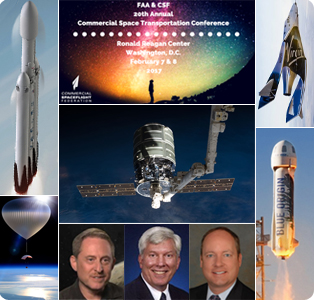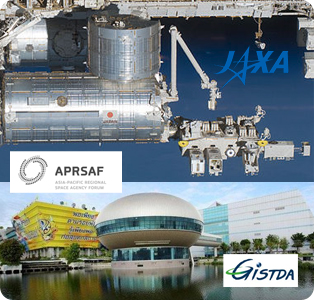20th Commercial Space Transportation Conference Expecting 300 Attendees
|
MONDAY Ongoing…
|

![]() = All times
= All times
for terrestrial events in local time unless noted.
![]() = All times for international terrestrial events in local time unless noted.
= All times for international terrestrial events in local time unless noted.
![]() = All times for space events, and…
= All times for space events, and…
![]() = All times for international space / astro events in Hawaii Standard Time unless noted. Add 10 hours to obtain UT (‘Universal Time;’ Greenwich, England).
= All times for international space / astro events in Hawaii Standard Time unless noted. Add 10 hours to obtain UT (‘Universal Time;’ Greenwich, England).
Weekly Planet Watch – Evening Planets: Venus (SW), Mars (SW), Jupiter (S), Uranus (SW); Morning Planets: Mercury (ESE), Saturn (SE).
3rd Space Environment and Kibo Utilization Workshop Organized by APRSAF in Bangkok, Thailand
The Asia-Pacific Regional Space Agency Forum (APRSAF) is collaborating with local Thai organizations Geo-Informatics and Space Technology Development Agency (GISTDA) and National Science and Technology Development Agency (NSTDA) as well as the Japan Aerospace Exploration Agency (JAXA) to hold the Space Environment and Kibo Utilization Workshop Feb 9-10 at the Vayupak Convention Center in northern Bangkok, Thailand. This Workshop, co-chaired by Kritsachai Somsaman of NSTDA and Fumiaki Tanigaki of JAXA, provides leading edge information on microgravity experimentation and various other fields of space research with the intention of encouraging utilization of experimental capacity provided by Kibo. The Japan Experimental Module aka “Kibo” is the largest single International Space Station module with total mass over 24,000kg. It was provided by Japan to advance science research on orbit and consists of 6 major elements: Pressurized Module, Exposed Facility, Experiment Logistics Module-Pressurized Section, Experiment Logistics Module-Exposed Section, Japanese Experiment Module Remote Manipulator System, and Inter-orbit Communication System. APRSAF in its 25th year of operations to enhance space activities in the Asia-Pacific region includes participation of Space agencies, governmental bodies, private companies, universities, and research institutes from 45 countries and regions as well as 28 international organizations. (Image Credit: APRSAF, JAXA, GISTDA) |
Continued from…
TUESDAY
|
![]() Feb 7-9 — Keck Institute for Space Studies, Caltech, JPL, Pasadena CA: Workshop: Optical Communication on SmallSats: Enabling the Next Era in Space Science – Part 2.
Feb 7-9 — Keck Institute for Space Studies, Caltech, JPL, Pasadena CA: Workshop: Optical Communication on SmallSats: Enabling the Next Era in Space Science – Part 2.
![]() Feb 7-9 — National Academies, Washington DC: Meeting: A Midterm Assessment of Implementation of the Decadal Survey on Life and Physical Sciences Research at NASA.
Feb 7-9 — National Academies, Washington DC: Meeting: A Midterm Assessment of Implementation of the Decadal Survey on Life and Physical Sciences Research at NASA.
![]() Feb 7 — Mercury: At aphelion, 04:00.
Feb 7 — Mercury: At aphelion, 04:00.
![]() Feb 7 — Apollo Asteroid 2017 BQ6: Near-Earth Flyby (0.017 AU).
Feb 7 — Apollo Asteroid 2017 BQ6: Near-Earth Flyby (0.017 AU).
![]() Feb 7 — Apollo Asteroid 2017 BU: Near-Earth Flyby (0.039 AU).
Feb 7 — Apollo Asteroid 2017 BU: Near-Earth Flyby (0.039 AU).
![]() Feb 7 — Apollo Asteroid 2015 BN509: Near-Earth Flyby (0.042 AU).
Feb 7 — Apollo Asteroid 2015 BN509: Near-Earth Flyby (0.042 AU).
![]() Feb 7 — Amor Asteroid 2017 BF29: Near-Earth Flyby (0.055 AU).
Feb 7 — Amor Asteroid 2017 BF29: Near-Earth Flyby (0.055 AU).
![]() Feb 7 — Apollo Asteroid 2016 YN1: Near-Earth Flyby (0.078 AU).
Feb 7 — Apollo Asteroid 2016 YN1: Near-Earth Flyby (0.078 AU).
WEDNESDAY
![]() Feb 8-10 — NASA, Pasadena CA: 2020 Mars Rover Third Landing Site Workshop; at Doubletree Hotel – Monrovia.
Feb 8-10 — NASA, Pasadena CA: 2020 Mars Rover Third Landing Site Workshop; at Doubletree Hotel – Monrovia.
![]() Feb 8 — Aten Asteroid 2017 BM3: Near-Earth Flyby (0.032 AU).
Feb 8 — Aten Asteroid 2017 BM3: Near-Earth Flyby (0.032 AU).
![]() Feb 8 — Apollo Asteroid 2016 YJ4: Near-Earth Flyby (0.045 AU).
Feb 8 — Apollo Asteroid 2016 YJ4: Near-Earth Flyby (0.045 AU).
THURSDAY
![]() Feb 9, 10 — JPL/Caltech, NASA, Pasadena CA: von Kármán Lecture Series 2017: Glacial Ice Melt and Sea Level Rise; Alex Gardner, Earth Scientist, JPL.
Feb 9, 10 — JPL/Caltech, NASA, Pasadena CA: von Kármán Lecture Series 2017: Glacial Ice Melt and Sea Level Rise; Alex Gardner, Earth Scientist, JPL.
![]() Feb 9-10 — Geo-Informatics and the Space Technology Development Agency, National Science and Technology Development Agency, JAXA Space Environment Utilization Working Group, Asia-Pacific Regional Space Agency Forum (APRSAF), Bangkok, Thailand: Space Environment and Kibo Utilization Workshop.
Feb 9-10 — Geo-Informatics and the Space Technology Development Agency, National Science and Technology Development Agency, JAXA Space Environment Utilization Working Group, Asia-Pacific Regional Space Agency Forum (APRSAF), Bangkok, Thailand: Space Environment and Kibo Utilization Workshop.
![]() Feb 9-11 — Space Center Houston, NASA JSC, Houston TX: 23rd Annual Space Exploration Educators Conference; all teachers for kindergarten to 12th grade, program focus on Moon, Mars, ISS with Astronaut lectures and hands-on learning.
Feb 9-11 — Space Center Houston, NASA JSC, Houston TX: 23rd Annual Space Exploration Educators Conference; all teachers for kindergarten to 12th grade, program focus on Moon, Mars, ISS with Astronaut lectures and hands-on learning.
![]() Feb 9 — Moon: 3.9° S of Beehive Cluster, 13:46.
Feb 9 — Moon: 3.9° S of Beehive Cluster, 13:46.
![]() Feb 9 — Apollo Asteroid 2017 BP30: Near-Earth Flyby (0.038 AU).
Feb 9 — Apollo Asteroid 2017 BP30: Near-Earth Flyby (0.038 AU).
FRIDAY
![]() Feb 10 — Royal Astronomical Society, London, United Kingdom: Meetings – Understanding the Space Environment Before the Space Age; Timing and Spectroscopy in the New Era of X-ray Astronomy.
Feb 10 — Royal Astronomical Society, London, United Kingdom: Meetings – Understanding the Space Environment Before the Space Age; Timing and Spectroscopy in the New Era of X-ray Astronomy.
![]() Feb 10 — NASA, Online: Application Due: NASA Planetary Geology and Geophysics Undergraduate Research Program – Summer 2017.
Feb 10 — NASA, Online: Application Due: NASA Planetary Geology and Geophysics Undergraduate Research Program – Summer 2017.
![]() Feb 10 — Moon: Full (Snow Moon), 14:33.
Feb 10 — Moon: Full (Snow Moon), 14:33.
![]() Feb 10-11 — Penumbral Lunar Eclipse: Sun, Earth, and Moon align in an almost straight line; visible in Europe, Much of Asia, Africa, North America, South America, Pacific, Atlantic, Indian Ocean, Arctic, Antarctica; begins 22:34:14 UT, max 00:43:49 Feb 11, ends 02:53:25.
Feb 10-11 — Penumbral Lunar Eclipse: Sun, Earth, and Moon align in an almost straight line; visible in Europe, Much of Asia, Africa, North America, South America, Pacific, Atlantic, Indian Ocean, Arctic, Antarctica; begins 22:34:14 UT, max 00:43:49 Feb 11, ends 02:53:25.
![]() Feb 10 — Aten Asteroid 2014 DV110: Near-Earth Flyby (0.025 AU).
Feb 10 — Aten Asteroid 2014 DV110: Near-Earth Flyby (0.025 AU).
SATURDAY
![]() Feb 11 — Jet Propulsion Laboratory, NASA/Caltech, Pasadena CA: Marsbound and the Search for Life – Educator Workshop; grades K-12 educators learn how to use engineering design process while teaching students to identify criteria for success and work within project limitations, 10:00-13:00.
Feb 11 — Jet Propulsion Laboratory, NASA/Caltech, Pasadena CA: Marsbound and the Search for Life – Educator Workshop; grades K-12 educators learn how to use engineering design process while teaching students to identify criteria for success and work within project limitations, 10:00-13:00.
![]() Feb 11 — Moon: 0.8° S of Regulus, 04:04.
Feb 11 — Moon: 0.8° S of Regulus, 04:04.
![]() Feb 11 — Amor Asteroid 2017 BX6: Near-Earth Flyby (0.057 AU).
Feb 11 — Amor Asteroid 2017 BX6: Near-Earth Flyby (0.057 AU).
![]() Feb 11 — Comet 45P/Honda-Mrkos-Pajdusakova: Near-Earth Flyby (0.083 AU).
Feb 11 — Comet 45P/Honda-Mrkos-Pajdusakova: Near-Earth Flyby (0.083 AU).
SUNDAY
![]() Feb 12-17 — Swiss Institute for Particle Physics (CHIPP), Swiss Academy of Sciences, Sorenberg, Switzerland: Swiss Institute for Particle Physics (CHIPP) Winter School of Particle Physics.
Feb 12-17 — Swiss Institute for Particle Physics (CHIPP), Swiss Academy of Sciences, Sorenberg, Switzerland: Swiss Institute for Particle Physics (CHIPP) Winter School of Particle Physics.
![]() Feb 12-18 — Univeristy of KwaZulu-Natal, Astrophysics and Cosmology Research Unit, National Institute for Theoretical Physics, National Research Foundation, KwaZulu-Natal, South Africa: Cosmology on Safari 2017.
Feb 12-18 — Univeristy of KwaZulu-Natal, Astrophysics and Cosmology Research Unit, National Institute for Theoretical Physics, National Research Foundation, KwaZulu-Natal, South Africa: Cosmology on Safari 2017.
![]() Feb 12 — Apollo Asteroid 2017 BK32: Near-Earth Flyby (0.027 AU).
Feb 12 — Apollo Asteroid 2017 BK32: Near-Earth Flyby (0.027 AU).
![]() Feb 12 — Apollo Asteroid 2015 QR3: Near-Earth Flyby (0.034 AU).
Feb 12 — Apollo Asteroid 2015 QR3: Near-Earth Flyby (0.034 AU).
![]() Feb 12 — Aten Asteroid 2017 BO6: Near-Earth Flyby (0.047 AU).
Feb 12 — Aten Asteroid 2017 BO6: Near-Earth Flyby (0.047 AU).
![]() Feb 12 — Apollo Asteroid 2014 QC3: Near-Earth Flyby (0.050 AU).
Feb 12 — Apollo Asteroid 2014 QC3: Near-Earth Flyby (0.050 AU).

